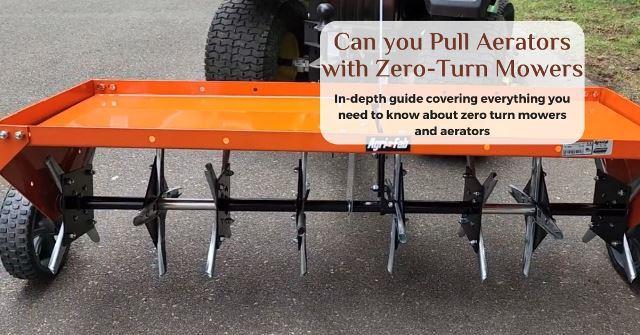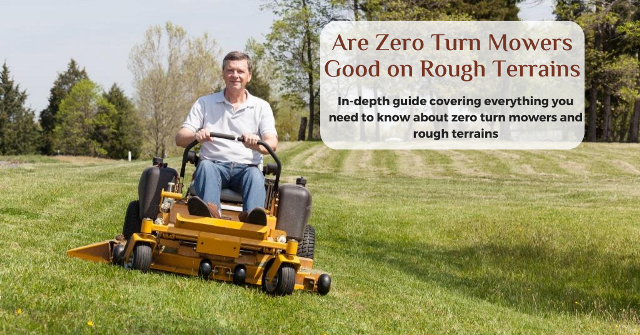There are way too many goody-goody reasons to aerate your lawn; you let in ventilation, water, and space for the grasses to plant properly into the soil. If you’re wondering whether your zero-turn mower can pull such weight-loving equipment as an aerator, chances are you might have imagined a situation with a nasty outcome. Truth be told, things can go downtown if not done with care.
The most preferable weight to place on an aerator is 200 pounds, anything more than that will simply become a risk-taking trip; the percentage of your mower surviving such a stint, in the long run, will be 50/50. The problem is that not every terrain complies with 200 pounds or less of weight. The more compact your lawn is, the tougher it is for the aerator to penetrate, causing you to put more pressure to smoothen the condition.
On a general note, it’s very possible to pull an aerator with a zero-turn mower successfully, but whether or not your zero-turn mower can handle an aerator is genuinely based on the condition of your terrain and machine— which is the reason for this discussion.
In this article, I will be deliberating if your zero-turn mower can pull an aerator in regards to certain determining factors.

To Pull an Aerator, Your Zero-Turn Mower Needs Enough Horsepower
Since we’re measuring a safe amount of 200Ibs (I acknowledge some people might exceed this mark) including your weight on the machine – which could round the number to 500 Ibs – your zero-turn should robustly be fed with sufficient power to pull the weight around your lawn. Anything less than 23hp is a pigmented red flag and should be a hard pass.
I understand that zero-turn mowers could be built to pull heavy stuff, but that function is far from the primary reason which is mowing, especially when the discussion is about weighty aerators. Some busy bees might revolt by saying their engines are below 23hp and have been pulling a thousand pounds for hundred years, but I strongly don’t advise that. Even if you succeed a couple of times, you will be seriously deteriorating your mower’s life span as you go.
Transmission Systems Determine The Success of Your Aerating Task
The first big flop that would happen to sour your trip is an injured transmission system. Specifically, the Hydro-Gear 2800; these buddies are not tough enough to suit the struggle and will slump if you put pressure on them. Even worse; if your lawn is peppered with obstacles that would require you to take sharp turns, it will take much longer to complete the chore as you would be maneuvering at significantly slower speeds. If your transmission system is the HG-3100 and above, you’re in a much better position to take swift bends around obstacles as you aerate your yard.
The Flatter The Terrain, The Better, Safer Aeration You Achieve
Since your zero-turn mower is already throwing all of its power and transmission on pulling an aerator, the last tests your machine would like to encounter are bumps, hills, and ditches. Although, if you have a commercial-grade zero-turn with a durable amount of horsepower and transmission, you will most likely scale through this stage with the breeze.
So, unless your mower has an equally aggressive engine and transmission system, going uphill with an aerator attached like a tail will wear out your tires or even knock down the transmission system. Even worse, you could be exposed to accidents if the slopes dip at dangerous angles. If you must ride over hills, it is much safer to go up and down the hill than to go side to side.
Commercial and Residential Aeration Influences Your Zero-Turn Mower Differently
The size of your yard matters significantly if you consider aeration with your precious zero-turn mower. If you own a residential grade zero-turn, it is best to adhere to the required number it can mow, it isn’t advisable to dive into professional aeration with even a high-grade residential mower. This is because the more frequently you tow the aerator, the easier for your mower to wear out. However, if you own a commercial-grade mower that can be used for professional use, you can as well push the limits.
Porous Soil Exerts Lesser Strain on Your Zero-Turn Mower During Aeration
Differences in habitual climate are one of the reasons why there isn’t a specific ‘right way’ to go about aerating a lawn. In some places, the soil is well-moisturized by rain and offers little resistance when you poke into the surface, and in other situations, due to lack of moisture, the soil gets really compact and unwilling to be punctured. In most cases, the adamant category of soil leans closer to clay soil instead of loamy soil, so a need to loosen up the water-resistant feature is required for grass seeds to germinate properly.
The tines of the aerator are mostly 3-inches in length, so if you run over a spot and discover that the tines don’t fully poke through, it simply states that your terrain might do a little with water sprinklers before getting aerated. By doing this, you reduce a great deal of strain on your zero-turn mower and the aerator itself.
Should I Go For The Spike or Plug Aerators?
The Spike or Plug aerators are the two main types of aeration methods; the spikes look just as they insinuate– sharp spear-like rods that poke into the soil to give nutrients, air, and water space to feel welcome, while the plugs are tube-like sharp rods that dig out clumps of soil in tiny cylindrical shapes as you roll across the terrain. Matter of fact, the plugs do a much better job because they reduce contraction that loosens the soil even better. So, if your zero-turn mower can handle a durable pull-behind aerator, I strongly suggest the plugs.
One of the most sought and well-trusted pull-behind plug aerators is the Agri-fab aerator (view on amazon); they come with 32 galvanized 3-inch core plugs that dig into the soil effectively. Also, the 48-inch aerator runs on flat-free tires so you don’t have to bother about filling them at all.
The Verdict
You can pull an aerator with your zero-turn mower. It just depends on all I’ve discussed above. Conclusively, it is crucial to match the correct power to how much weight you’re exerting on the machine, otherwise, there’d be outcomes you wouldn’t be so happy about.
